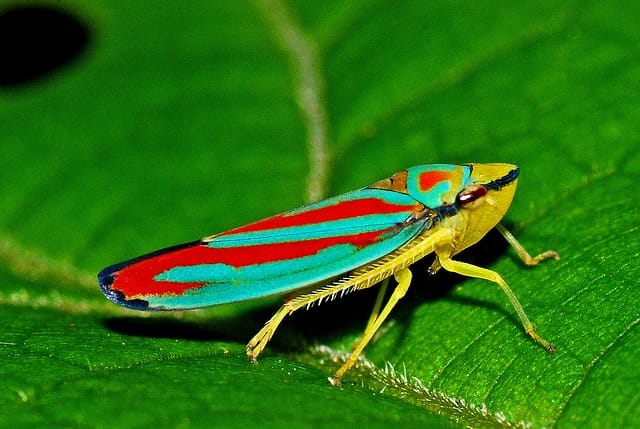Fighting gardening pests: Leafhoppers
Gardening can be incredibly rewarding, but it also comes with its fair share of challenges â?? especially when it comes to dealing with pests

In this article:
- Introduction
- Identifying Leafhoppers
- Signs of Leafhopper Infestation
- Understanding Leafhopper Behavior
- Natural Predators of Leafhoppers
- Organic Control Methods
- Chemical Control Options
- Preventing Leafhopper Infestations
- Monitoring and Early Detection
- Combating Leafhoppers on Specific Plants
- Integrated Pest Management for Leafhoppers
- Conclusion
Introduction
Gardening can be incredibly rewarding, but it also comes with its fair share of challenges – especially when it comes to dealing with pests. Leafhoppers are common garden pests that can cause significant damage to plants if left unchecked. In this article, we will explore various methods for identifying, preventing, and controlling leafhopper infestations, both organically and chemically.
Identifying Leafhoppers
Leafhoppers are small, wedge-shaped insects that are typically green or yellow in color. They have a distinctive hopping behavior and are often found on the undersides of plant leaves. Leafhoppers are known for their ability to quickly move from plant to plant, making them challenging to control.
Signs of Leafhopper Infestation
Signs of a leafhopper infestation include stippling or white speckling on leaves, yellowing or browning of leaf edges, and a decrease in plant vigor. Additionally, if you observe tiny, nymphal leafhoppers on your plants, it is an indication of an ongoing infestation. Prompt action is necessary to save your plants from severe damage caused by leafhoppers.
Understanding Leafhopper Behavior
Leafhoppers are sap-sucking insects that feed on plant cell fluids. This feeding activity can cause tissue damage, stunting growth, and impairing the plant's ability to photosynthesize. Leafhoppers are most active in warm weather and tend to reproduce rapidly, leading to population explosions if not tackled early on.
Natural Predators of Leafhoppers
Encouraging natural predators of leafhoppers, such as ladybugs, lacewings, and spiders, can be an effective method of controlling leafhopper populations. These beneficial insects feed on leafhoppers and help maintain a balance in your garden ecosystem. Creating a welcoming habitat for these predators can make your garden less appealing to leafhoppers.
Organic Control Methods
Organic control methods for leafhoppers include techniques such as manual removal, using neem oil or insecticidal soap sprays, and introducing insect-repelling plants. By regularly inspecting your plants and employing these methods, you can effectively minimize leafhopper populations and protect your garden organically.
Chemical Control Options
In severe cases where natural and organic methods have failed, chemical control options may need to be considered. Insecticides specifically formulated for leafhopper control can be applied, but it's important to follow the instructions carefully and use the products sparingly to minimize harm to beneficial insects and the environment.
Preventing Leafhopper Infestations
Prevention is always better than cure. Some preventive measures include maintaining plant health through proper watering and fertilization, removing weeds that could serve as leafhopper hosts, and avoiding the use of excessive nitrogen-based fertilizers. Additionally, planting a diverse range of species can help reduce the risk of widespread infestations.
Monitoring and Early Detection
Regular monitoring of your garden is crucial for early detection of leafhopper infestations. By being vigilant and inspecting the undersides of leaves, you can identify leafhoppers at the nymph stage, before they mature and cause extensive damage. Early intervention will give you the best chance of success in controlling these pests.
Combating Leafhoppers on Specific Plants
Some plants are more prone to leafhopper infestations than others. Understanding the specific plants that leafhoppers favor and taking extra precautions can help protect vulnerable plants. For example, installing physical barriers and using companion planting techniques can deter leafhoppers from causing harm to your desired plants.
Integrated Pest Management for Leafhoppers
Adopting an integrated pest management (IPM) approach is highly recommended for long-term leafhopper control. IPM involves a combination of prevention, monitoring, cultural control practices, biological control, and, where necessary, the use of pesticides. By striking a balance between these methods, you can effectively manage leafhopper populations and minimize plant damage.
Conclusion
Gardening pests like leafhoppers can be a thorn in the side of any gardener, but with proper knowledge and proactive measures, they can be controlled. By identifying leafhopper infestations, understanding their behavior, utilizing natural predators, employing organic and chemical control methods if needed, and implementing preventive measures, you can maintain your garden's health and enjoy bountiful harvests year after year.
